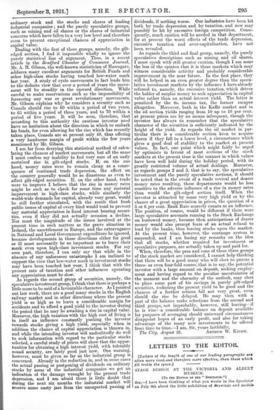LETTERS TO THE EDITOR.
[Letters of the length of one of our leading paragraphs are often more read,and therefore more effective, than those which fill treble the space.] STAGE DESIGN AT THE VICTORIA AND ALBERT MUSEUM. [To THE EDITOR Of rue " STMOTATOR."] Sns,—I have been thinking of what you wrote in the Spectator on July 9th about the little exhibition of drawings and models
for theatre scenes, &c., at South Kensington. A matter of regret it is, indeed, that the show should be so small and in a far-off room. There have been quite a few official exhibitions of theatrical art held in Europe, municipal affairs and interna- tional in the exhibits : Zurich, 1914.—I was there as a guest of honour; Adolphe Appia the other honoured guest, althotigh a Swiss. Still, we were " featured " as it is called. Mannheim, 1913.—I showed here, but not to the same extent. Budapest, 1914. Warsaw, 1914. Parma, 1913.—Only this was an "all Italian " affair. And now in Amsterdam this autumn-winter there is to be another such show.
Let me tell you, too, that most of these exhibitions were organized perfectly. Zurich paid for all transport of work to and fro—models, masks, marionettes, books (old books, of course), posters—and paid, I think, some 300 francs towards certain artists' travelling expenses (about £10 to £12 in those days). Zurich and Mannheim both issued catalogues as big as books. So, as you see, alas! we shall not be the first to officially co such an exhibition. Again, in each case a very thorough plan was made out. Everyone and anyone was not invited to exhibit. Only original things belonging to the newer school and ancient things of the very old and famous schools. These arranged with skill and common sense. Zurich—four large halls trans- formed into about twenty-eight smaller rooms, each room designed by an architect; simple; no fuss. Each had windows for lighting the exhibits; false windows, of course. A large plan sent to each guest showing proposed space allotted to him, and inviting his co-operation. I had three small rooms to myself, and my school had three large rooms. By large I mean thirty-two feet by about twelve feet. I could tell in detail all about Zurich, but will reserve it for later should this idea of yours come to something.
You were right in saying models of my work could be obtained—but authentic ones only from me—and I could give them dozens of prints of scenes and plans of theatres and sec- tions and things unseen in England, unknown for most part out of Italy, and would beg to be allowed to lend a little advice in the ancient theatre section, for it is one I do know something about. You could have gone much further in your promise of things which could be loaned. I would suggest Mr. W. J. Laurence as one of the few men able to speak about the ancient section of such a show. You probably know lots of his articles on the subject and his book, a book I have tried to get and cannot. Then there is Mr. E. K. Chambers, who wrote' The Mediaeval Stage. These two should be written to, their names suggested. Could not you do it, and could not the Spectator take an active interest in the whole affair? You mention Bakst, Picasso, Komisarjevsky, but you forget Adolphe Appia, bigger than all these three, and let me recommend a young man, Rochus Gliese, a German, quite the best German to my thinking.
The modern Italians have no one. It is only their actors who are at all remarkable, and these, of course, one cannot exhibit in glass cases. But there could be an Italian room solely of ancient marvels. Russia, Germany, Sweden, Holland, Italy, France, Spain, Hungary, Austria, Switzerland, Japan and China, and America could all be drawn upon.—I am, Sir,



































 Previous page
Previous page